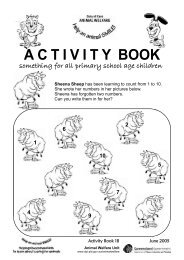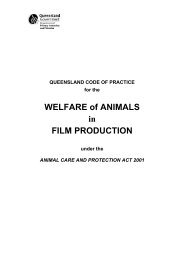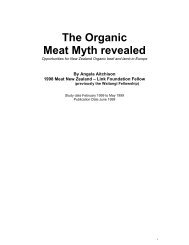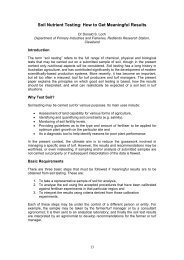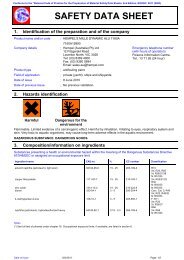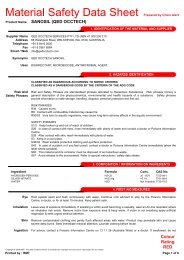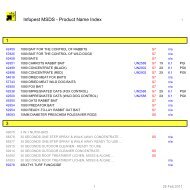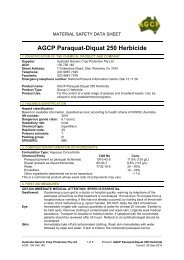Create successful ePaper yourself
Turn your PDF publications into a flip-book with our unique Google optimized e-Paper software.
<strong>Soil</strong>-<strong>Borne</strong> <strong>Turfgrass</strong> <strong>Diseases</strong><br />
Kaylene Bransgrove<br />
Department of Primary Industries and Fisheries,Redlands Research Station,<br />
Cleveland.<br />
Introduction<br />
<strong>Soil</strong>-borne turfgrass diseases affect all warm-season grasses and cause major<br />
losses of turf quality. They are caused primarily by fungi and there are few examples<br />
of true disease resistance in turfgrass. All turf applications are affected, from home<br />
lawns to golf greens, although the incidence and severity of disease is usually higher<br />
in highly managed applications. Examples include golfing and bowling greens where<br />
the turf is cut low and frequently. Both incidence and disease severity are influenced<br />
by plant health, site factors like shading and sometimes directly by mowing height.<br />
At times environmental factors like shading, water logging or heat stress can cause<br />
severe turf injury and stress and are misdiagnosed as diseases.<br />
Commonly used warm-season turfgrass species are Axonopus compressus and A.<br />
fissifolius (broad and narrow leaf carpetgrass respectively), Cynodon dactylon and C.<br />
dactylon x C. transvaalensis (green and hybrid green couches respectively),<br />
Dactyloctenium australe (sweet smothergrass), Digitaria didactyla (blue couch),<br />
Paspalum vaginatum (seashore paspalum), Pennisetum clandestinum (kikuyu),<br />
Stenotaphrum secundatum (St. Augustinegrass) and Zoysia spp. (Zoysiagrass).<br />
Major Root and Crown <strong>Diseases</strong><br />
Major root and crown diseases include Kikuyu Yellows (Verrucalvus flavofaciens),<br />
Pythium diseases, Fairy Rings, Spring Dead Spot (Leptosphaeria spp.), Rhizoctonia<br />
Patch diseases, Fusarium diseases and Anthracnose (Colletotrichum graminicola).<br />
Spring Dead Spot and Anthracnose are not strictly soil borne diseases, their spores<br />
survive in plant material and, anthracnose particularly, can also be a foliar disease<br />
and disseminated aerially. They do however cause severe root, stolon and crown<br />
rots and large patch deaths. They have been included in this summary for that<br />
reason. The causal agents of Kikuyu Yellows, Pythium, Fusarium and Rhizoctonia<br />
diseases can survive in the soil itself and are considered soil-borne diseases.<br />
Kikuyu Yellows<br />
Kikuyu yellows is caused by the oomycete Verrucalvus flavofaciens and is the<br />
primary disease of turf and pasture types of kikuyu. The causal agent infects the root<br />
system and causes severe root rot and root and plant death. As an oomycete the<br />
pathogen thrives in the presence of high soil moisture. Disease symptoms are<br />
consistent and are expressed as a yellowing which becomes circular as the affected<br />
area expands. The centre of the circle dies and as kikuyu does not regrow in the<br />
centre, the patch is colonised by other grasses and broadleaf weed species. This<br />
can create an uneven, non-uniform surface. The disease usually appears in spring,<br />
progressing through summer and autumn. It is often more noticeable in dry weather.<br />
While there are no chemical controls for the disease, it can be masked to a degree<br />
by nitrogen fertiliser application.<br />
69
Kikuyu yellows, a patch disease of Pennisetum clandestinum (kikuyu) caused by a<br />
fungus Verrucalvus flavofaciens.<br />
Pythium <strong>Diseases</strong><br />
Pythium is another oomycete, or water mould, and is favoured by high soil moisture.<br />
A number of Pythium species cause turf diseases.<br />
Damping Off<br />
This is usually a seedling disease, but can be seen on adult turf. Affected seedlings<br />
are water soaked, stunted, become wilted and withered and die. The disease is<br />
promoted by warm, humid conditions in conjunction with wet soil.<br />
Root and Crown Rot<br />
The roots and crowns are affected. Root and crown rot can be a problem where<br />
excessive moisture is kept in the soil profile due to inadequate drainage.<br />
Pythium Blight<br />
This is a leaf infection that creates water-soaked looking patches—leaves in the<br />
patch may ‘stick’ together and white mycelium (fungal strands) may be seen in the<br />
morning or in periods of high humidity. The infection and destruction process can be<br />
very fast (such as overnight).<br />
Fairy Rings<br />
Fairy Rings are caused by numerous fungal species; a common few are Lycoperdon<br />
spp., Marasmius spp. and Tricholoma spp. Symptoms take three forms: no<br />
symptoms on turf but the presence of mushrooms, greening of the turf and turf death.<br />
All symptoms are in rings that enlarge from year to year. Rings can coalesce and<br />
form larger rings, scalloped rings or arcs.<br />
Leptosphaeria Spring Dead Spot<br />
There are two species of Leptosphaeria that cause spring dead spot, but in Australia<br />
Leptosphaeria narmari is the predominant species. Green couch, St Augustinegrass,<br />
Broad Leaf Carpetgrass and Kikuyu are known to be affected. The roots and<br />
70
hizomes become discoloured and rotten and sunken. On the grass sward, circular<br />
patches may be noted in autumn and through winter and spring, or only in spring as<br />
turf moves out of winter dormancy. The incidence of the disease may be elevated by<br />
high nitrogen application.<br />
Rhizoctonia Patch <strong>Diseases</strong><br />
The diseases most commonly known as “brown patch” and “large patch” are caused<br />
by a range of fungi in the Rhizoctonia group including R. solani. The diseases have<br />
been documented in most warm-season grass genera and are prevalent in warm,<br />
humid conditions in spring through to autumn. Incidence may also be elevated by<br />
high nitrogen applications. Patches of turf usually become light green in colour, then<br />
yellow, before degenerating into a brown discoloured area. Individual plants may<br />
have a dark purplish border and rot at the base of the leaf sheaths and/or stems.<br />
Fusarium <strong>Diseases</strong><br />
Winter Fusarium is caused by the fungus Microdochium nivale. It was identified for<br />
many years as a Fusarium species, hence the usage of the name Fusarium. It is<br />
primarily a cool season and winter disease, and a pathogen of cool season turf,<br />
however it has been recorded on warm-season grasses. It is often characterised by<br />
an orange/brown colour in the patch and patch borders.<br />
Anthracnose<br />
Included in this summary because of its ability to cause severe crown rot,<br />
anthracnose, caused by Colletotrichum graminicola, is prevalent in cool, wet<br />
conditions and is primarily a disease of cool season grasses. Whilst it can cause<br />
severe damage to turf, it is considered a weak pathogen, found where the grass is<br />
under pressure from another (usually environmental) factor.<br />
Control<br />
Cultural control for most of these diseases is all about ensuring soil moisture is<br />
adequate but not high or excessive. In some soils drainage needs to be improved,<br />
while for others, where good drainage is inherent, good irrigation management<br />
practices are need to be employed.<br />
Many diseases are also facilitated by high rates of applied nitrogen, often because<br />
nitrogen facilitates fast growth rates, producing plentiful amounts of young, easily<br />
infected tissue. Where it is possible, fertilise more frequently with less fertiliser to<br />
promote steady growth rates.<br />
There is a range of chemicals registered for the control of diseases in turf, some<br />
being registered for use against several diseases. Local chemical re-sellers can<br />
provide up-to-date information on current chemical registrations and chemical<br />
recommendations.<br />
71



